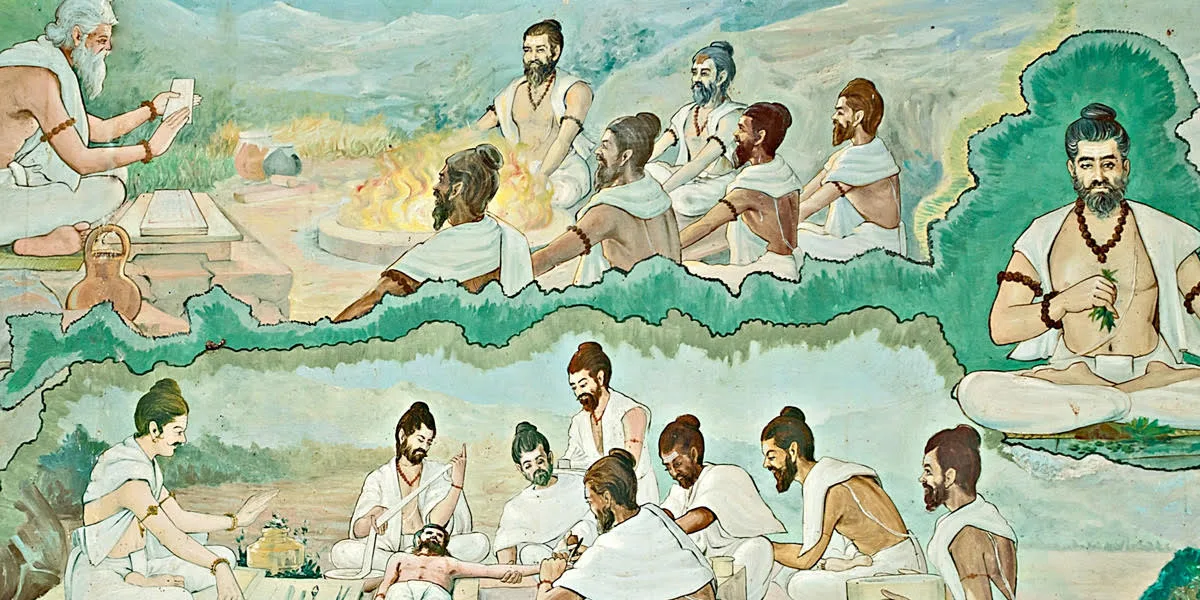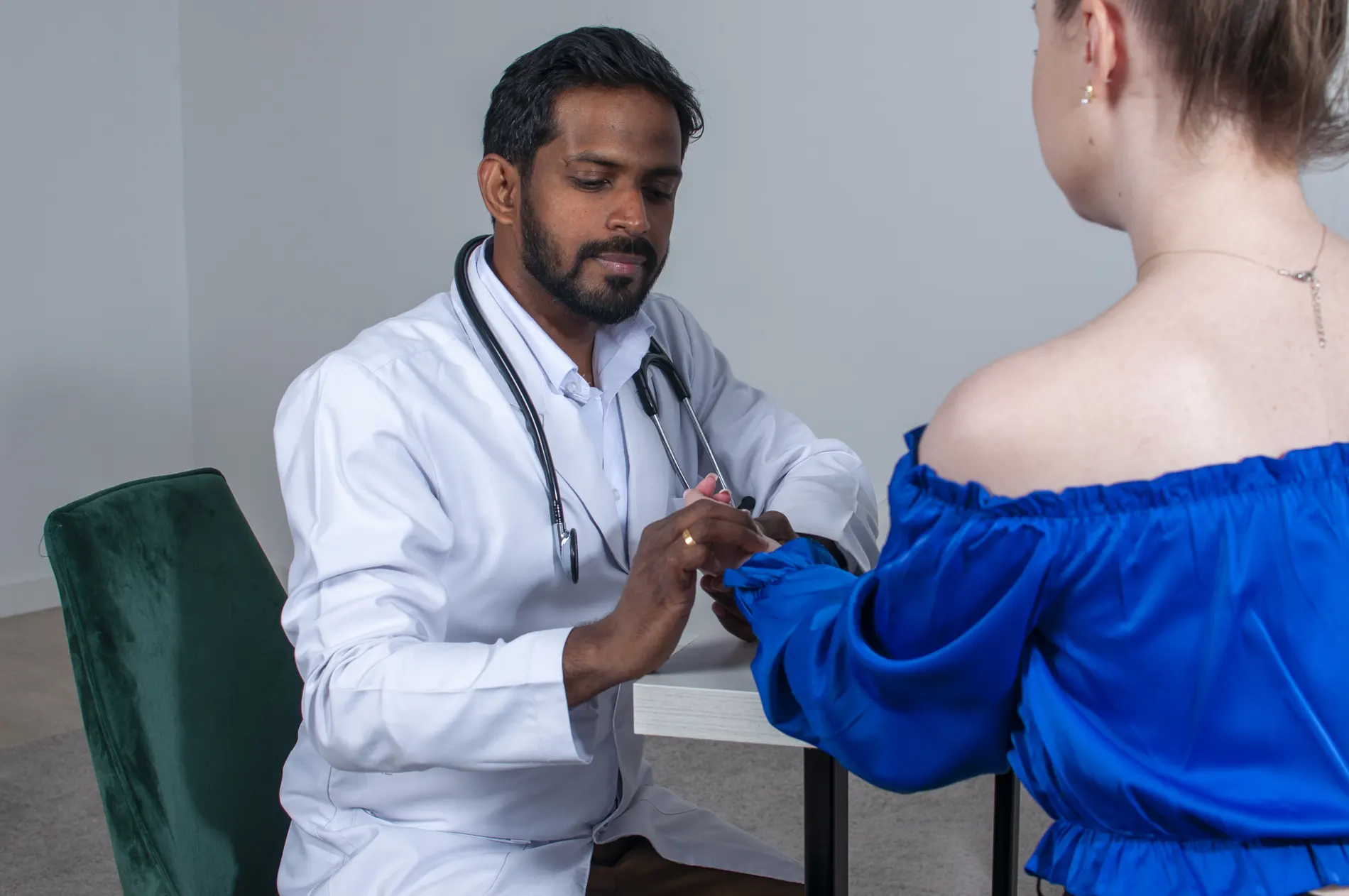Ayurveda
- The detailed knowledge on life

What is Ayurveda? Ayurveda is an ancient lifestyle and medical science approved by the Government of India and presently practised as the official medical system of India. This system dates back to 3000-5000 years which has recorded evidences and research materials. Ayurveda has methods to maintain health and treat various health conditions. Ayurveda considers the three energies in the body namely Vata Dosha, Pitta Dosha and Kapha Dosha in understanding the balance and mis-balances within an organism. The balance of these three doshas is called as health and their mis-balance leads to disorders.
The aim of Ayurveda is maintain health in a healthy individual and to treat the mis-balances in the people who are having it by balancing the doshas through diet, regimen, therapies and herbal intake plan. Ayurveda also uses preparatory procedures like massages and Marma therapy, detox procedures named Panchakarma and Panchavidha shodhana and Rejuvenation procedures namely Rasayana and Vajikarana for maintaining health and treating the mis-balances.
Ayurveda has eight branches, They are Kayachikitsa, Balachikitsa/Kaumarabhrithyam, Graha Chikitsa/Bhuta vidhya, Shalyatantra, Damshtra chikitsa/Agada tantra/ Visha chikitsa, Jara chikitsa and Vrusha chikitsa. They are as follows:
Kayachikitsa
What is Kayachikitsa? The general medicine branch of Ayurveda which deals with all the bodily systems and its management is called as Kayachikitsa. Here the concept of “Agni’ - the internal fire within a human being is given the utmost consideration and protecting the Agni is main aim of Kayachikitsa. Agni is correlated to all the activities connected our metabolism including the action of digestive enzymes, the nervous system action which causes appetite, the cellular level metabolism which coverts energy etc. In Kayachikitsa, the concept of “Ama” also is having high significance. Kayachikitsa aims to prevent the formation of “Ama” or toxins in the body. It also aims at expelling the already formed toxins through Panchakarma or the Ayurvedic detox therapy. The conditions like psoriasis, irritable bowel syndrome and other digestive system disorders, diabetes, fever, hormonal mis-balances, nervous system related ailments, respiratory disorders, circulatory system disorders, urinary system disorders etc. are managed under this department. The method of treatment in Kayachikitsa includes individual diet, regimen, therapies, detox and herbal intake plan as per the proper assessment of dosha levels. This is one of the basic and important departments of Ayurveda. The principles of this branch of Ayurveda are used in all the treatment methods used the other departments of Ayurveda.
Balachikitsa/ Kaumarabhrithyam
What is Balachikitsa ?/ What is Kaumarabhrithyam? The Ayurvedic Paediatrics is called as Balachikitsa or Kaumarabhrithyam.“Bala” in Sanskrit language means “child” (“Kaumar”=Child). It deals with all the health concerns related to a child from the age 0 up to the age of 16. The health and well being of children is one of the utmost aims of Ayurveda. As children are unable to communicate their complaints in detailed manner always, this department gives high accent of deep understanding of children and finding the ultimate solutions for their health concerns through natural friendly measures. All child related ailments including metabolic errors, milestone related problems, brain and mind related disorders in children like autism, Attention Deficit/Hyperactive Disorders (AD/HD), mental retardation,stress, memory related disorders, neuro-muscular disorders and other disorders likeCerebral Palsy, Muscular Dystrophy, Paralysis etc. are managed under this department of Ayurveda. This department helps in maintain the health as well as it aims in treating various mis-balances associated with them. The treatment method in this department includes age based individual dose, counselling, herbal intake plan, diet, procedures and regimen after understanding the proper dosha level in children.
Graha chikitsa/ Manasika Chikitsa
What is Graha Chikitsa? What is Bhuta Vidya? The Ayurvedic department of psychology and psychiatry is called as Graha Chikitsa .This branch of Ayurveda deals with psychology and psychiatryis also called as “Bhuta Vidya”. It has methods of diagnosis and treatments for diseases affecting the mind. Graha Chikitsa deals with different factors that causes mis-balances of the mind. Graha in Sanskrit language means, which can be seen through microvision or understandable through a different dimension.The disorders of mind and microbes are often categorised under the “Graha”. Manasika in Sanskrit language means related to mind. The word Bhuta means, which posses a different dimension other than we can see or feel physically. The assessment conducted by this branch is done based on three doshas of named Vata, Pitta and Kapha and three gunas namely Sattva, Rajas and Tamas. The Sarvam method of Ayurvedic mind balancing and Samarthanam method of Yoga is used in this department. In this branch of Ayurveda the elements of Ayurvedic astrology, Ayurvedic mantras and Ayurvedic energy practices are also used. The supernatural sphere of energy which affects the mind is balanced with the various measures used in this department of Ayurveda. “Ragadi”emotions of mind which includes Raga, Dvesha, Lobha, Moha, Mada and Matsarya etc. are well managed with the principles of Manasika chikitsa of Ayurveda. This department in Ayurveda also deals with manasavikara (mental disorders) like kama (excess uncontrolled desire), soka (grief), abhyasuya (jealousy) on others and ubhayatmaka vikara (diseases wherein bothbody and mind are affected) like, unmada (psychosis, schizophrenia etc.) and apasmara (epilepsy). The treatment plan in this department includes mind balancing practices, diet plan, regimen, herbal intake plan, detox, therapies and rejuvenation plan for the complete recovery from various different mis-balances which affect the mind.
Urdwanga Chikitsa
What is Urdwanga Chikitsa? What is Shalakya Tantra? The Ayurvedic department which take cares of all the health condition which occurs above the neck region is called as Urdwanga chikitsa or Salakhya tantra. It is also known as Ayurvedic Ear-Nose-Throat department. This department also considers ophthalmology that corresponds to Ayurveda and deals with disorders of the brain, central nervous system, and skull.Some of the common conditions treated under this department are head ache, sinusitis, nasal polyps, anosmia,hyper-salivation/hypersialosis, tonsillitis, throat infections, loss of taste/ageusia, vertigo, vision and eye related problems and hearing loss. In short, as it is mentioned earlier this the branch in Ayurveda which deals with every health concerns above the neck region. The treatment methods include diet plan, regimen, herbal intake plan, detox, therapies and rejuvenation plan for the complete recovery from various different mis-balances associated with health concerns above the neck area.
Shalya Tantra
What is Shalya Tantra? The Ayurvedic department deals with various health concerns which requires invasive procedures or surgeries is called as Shalya Tantra. The Sushruta Samhita is one of the oldestclassical works in Ayurveda which narrates the first surgical treatments performed by great sage and physician Acharya Sushruta. Guru Susrutha is known as the “father of surgery” in Ayurveda. The ancient Indian surgeons were performing many complex operations, including cesarean sections, cranial surgeries, obstructed labor, how to conduct prosthetic surgery for artificial limbs, and cosmetic surgery on the nose, ears and other areas. These procedures were undertaken between the period of 3,000 and 5,000 years ago. The Shalya Tantra describes the appropriate equipment to use, bandages to wear, and sutures to utilize for various treatments. It also describes general processes, energy points (marmas), and even natural anaesthetic methods.Many pathological disorders, such as ulcers (non-healing ulcers and wounds also), varicose veins, inflammatory skin conditions, abscesses, warts, fractures, dislocations, anorectal cases like piles (haemorrhoids), fistula, fissure, cervical and lumbar spondylosis, etc. is managedunder the department of Shalya Tantra. The treatment methods include surgical procedures (major and minor), diet plan, regimen, herbal intake plan, detox, therapies including marma therapy and rejuvenation plan for the complete recovery from various different mis-balances associated with health concerns which comes under this branch of Ayurveda.
Damshtra chikitsa or Visha Chikitsa or Agada Tanthram
What is Damshtra Chikitsa? What is Visha chikitsa ? What is Agada tantra? - The Ayurvedic department deals with toxicology is called as Damshtra chikitsa or Visha Chikitsa or Agada Tanthram ). “Damshtra” means “poisonous teeth” ad “Agada” means”that in good health or medicine” and “Visha” means “poison”, in Sanskrit language. Damshtra Chikitsa, also known as Agada Tantra, is the area of Ayurvedic toxicology that deals with the prevention and treatment of poisons in the body.General bites and attackby animals, birds, insectsor worms etc. as well the poisoning through various other measures including food poisoning are well managed with the help of Damshtra chikitsa/Agada tantra. This branch also deals with the healing of various skin ailments caused due to various conditions including infections and allergies. Ayurveda has detailed researches on the Agada tantra and has a lot of effective medications. The treatment methods include diet plan, regimen, herbal intake plan, detox, therapies, minor surgical procedures, chanting mantras and rejuvenation plan for the complete recovery from various different mis-balances associated with health concerns which comes under this branch of Ayurveda.
Jara Chikitsa or Rasayana Chikitsa
The Ayurvedic department deals with Anti-ageing treatment which helps in reversing the wear and tear caused due to ageing is called as Jara Chikitsa or Rasayana Chikitsa). This branch of Ayurveda focuses on the method of ultimate longevity and rejuvenation, as well as ailments and disorders associated with ageing. In order to improve quality of life and live a healthy life filled with vigor and vibrancy, it discusses preventive healthcare, advices, treatments, and herbal remedies (Rasayana = which supports all the body tissue and helps to rejuvenate it). No matter the age of an individual, the degenerative problems are managed with the help of Jara chikitsa which recovers from getting old aged (Jara in Sanskrit language means ‘becoming old”). This branch of Ayurveda has various measures Rasayana or rejuvenation measures, such as the Aushadha Rasayana (herbs-minerals based), the Ahara Rasayana (diet and nutrition based), and the Achara Rasayana (behavioural discipline based). The Jara Chikitsa or Rasayana chikitsa system of healing contains techniques for enhancing strength, immunity, vitality, youthfulness, brilliance, pleasant emotionsand adding virtuousness. The treatment methods in Rasayana Chikitsa include diet plan, regimen, herbal intake plan, ghee intake plan, detox, therapies, staying in clean houses, celibacy practices, yoga, exercises and rejuvenation plan for the complete recovery from various different mis-balances associated with health concerns which comes under this branch of Ayurveda.
Vrusha Chikitsa or Vajikarana Chikitsa
What is Vrusha chikitsa? What is Vajikarana Chikitsa?The Ayurvedic department deals with the reproductive health and aphrodisiacs is called as Vrusha Chikitsa or Vajikarana Chikitsa. “Vrusha” means “Bull” and “Vaji” means “horse”, the aim of this branch in Ayurveda is to produce bull or horse like vigour within the organism. This branch in Ayurveda focuses on enhancing fertility and promoting the sexual well-being of both men and women. The physiology and anatomy of reproductive system is fully considered and all effort is done to retain the maximum potential and health. It is the unique branch in Ayurveda that discusses sexual health, potency, strength, excitability, regimens, procedures, diets, herbal medicines, and therapies to take care of physiology, anatomy and energy of the reproductive system. This department in Ayurveda also deals with treating the problems including erectile dysfunction, infertility, other hormonal mis-balances, premature ejaculation and sexual dysfunction.The treatment methods in Vajikarana Chikitsa includes diet plan, regimen, herbal intake plan, ghee intake plan, detox, therapies, marma chikitsa, yoga, exercises and strength improving plans for the fast re-balancing of doshas of body, body tissues and Agni (the metabolic fire), to maintain the balance and health.
In addition to the above major departments, there is also the department of Svasthavrutha (preventive medicine, community medicine, yoga and meditation department), Roganidana (Pathology department), Prasoothitantra evum Streeroga (Ayurvedic Gynecology and obstetrics), Panchakarma department (the department deals with the detox and rejuvenation), Dravyaguna vijnana (Ayurvedic pharmacology) and Rasasastra evum Bhaishajya kalpana (The department of pharmacy in Ayurveda which deals with the preparation of herbo-mineral preparations).
Dr.Varun Ram Raj, have undergone training in all the above departments of Ayurveda, in the Ayurvedic University as well during the internship period under the Government of Kerala. Immediately after the training, Dr.Varun was appointed to direct an Ayurvedic centre which was run by the pro-vice-chancellor of the University, this was the life changing Ayurvedic experience for him. During those days his professional activities started from 06:00 and finished around 20:30 each day. The early morning period he was performing the short procedures like Nasyam (nasal therapy), Vamanam (stomach cleansing therapy) etc. and during the day the procedures like Abhyangam, Shirodahara etc. were performed. Afternoon session involved the major Panchakarma procedures like Vasti, Sirovasthi etc. and the evening session had manual therapies like Marma therapy with accent given on sports injuries, paediatrics and musculoskeletal system related cases. There were courses of 3, 5 and 7 days Ayurveda, Panchakarma and Marma therapy and in that centre Dr.Varun worked daily with nearly 10 people who stayed there for the Ayurvedic treatments. The final steps in the treatment always included Rasayana and Vajikarana, which were the respective rejuvenation and strength promoting Ayurvedic treatment measures.
After nearly one and half of year of work in the above facility, Dr.Varun decided to continue his Ayurvedic education in the department of pharmacology, general medicine and rheumatology in Ayurveda. This three year period he co-operated with various major integrative hospitals, doctors and Universities, which dealt with different types of cases. During this period, it was the time to attend various acute cases of all departments. The three year period during this time, he concentrated in Ayurvedic pulse diagnosis, Individual diet, Panchakarma and Marma therapy under the guidance of great Ayurvedic teachers and Gurus. The pulse diagnosis was done in nearly 30-40 people daily by the group led by Dr.Varun and derived conclusions which helped him to assess the pulse with high accuracy, which is considered as the essential part of Ayurvedic diagnosis. The combination study of north Indian as well as south Indian Marma therapy was done during this period under the specialists from various parts of India. This is a manual therapy method using the 107 body point balancing, which is an essential technique in managing the doshas of our body. Regular performance of Marma leads to balance of doshas in a faster manner. The diet therapy and Panchakarma was also the major sphere researched by him, where most of the cases included skin care, hormonal balance and weight management. The diet and detox plan of each individual’s were directly controlled by the doctors including Dr.Varun Ram Raj, which gave high success rates in all the cases. The Ayurveda, Panchakarma and Marma therapy in India have developed in a faster rate, with a great global acceptance. In the recent future he have started Ayurvedic Retreat in India for his regular clients to visit Northern India and Southern India for Ayurveda (includes Panchakarma, Rasayana and Vajikarana) , Yoga and mind -balancing. The aim of this plan, is to show the genuine Ayurveda and Yoga to all his followers and to get all the classical Ayurvedic and Yoga essence from Government registered Ayurvedic practitioners in an affordable cost.
Presently he is focussed in Russian Federation and India, and his consultations gives accent in the general metabolism, musculoskeletal system, reproductive health care, neuroendocrine system and mind balancing. All these departments aims at the balance of doshas of body and mind (Vata, Pitta, and Kapha and Rajas and Tamas) with the help of classical Ayurvedic measures which includes diet, herbs, regimen, therapies, marma chikitsa/marma therapy, detox and rejuvenation. He is conducting consultations online, and offline. The direct consultations are available in the cities of Moscow, Saint-Petersburg, Dubai, New Delhi and Trivandrum. In case if you are planning to attend the consultations, you can appoint the consultations by writing a personal message to him or writing a email to coontact@drvarunramraj.com or you can contact him through social media site links given under the contact session.
Ayurveda is the essence of life, if followed properly; it helps to fulfill all the goals of life, staying in state of complete health.



